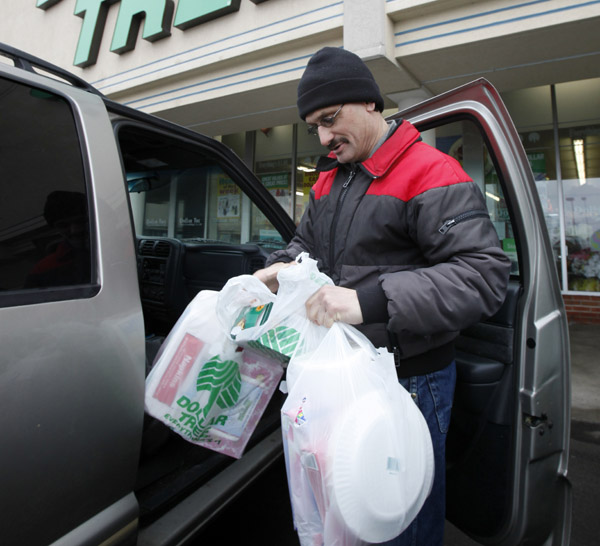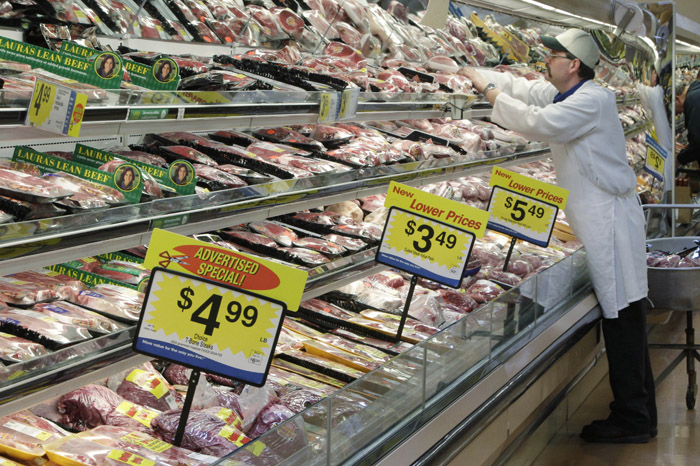WASHINGTON — Americans increased spending more than forecast in February as incomes climbed, easing concern that rising food and fuel costs might derail the consumer demand that makes up 70 percent of the economy.
Purchases increased 0.7 percent, the most since October, after advancing 0.3 percent the prior month, Commerce Department figures showed today in Washington. Another report showed the number of contracts to buy previously owned homes advanced for the first time in three months.
More than half the gain in spending last month reflected higher prices, one reason it will be difficult for households to contribute as much to economic growth this quarter as last. At the same time, the U.S. economy added jobs for the sixth consecutive month in February and the unemployment rate fell to the lowest level since April 2009, helping cushion the blow from a pickup in inflation.
“The increase in food and energy prices is a headwind for consumers, but not enough to turn into a concern” that spending might decline, said Julia Coronado, chief economist for North America at BNP Paribas in New York, who correctly forecast the gain in sales. “The picture for consumers is that they’re spending at a moderate pace. We are on a decent pace of expansion.”
An index of pending home sales increased 2.1 percent in February after a 2.8 percent drop the prior month, figures from the National Association of Realtors showed Monday. The data indicates the housing market is having trouble recovering as foreclosures mount.
“The foreclosure overhang is oppressing the industry,” said Ken Mayland, president of ClearView Economics in Pepper Pike, Ohio, who projected sales would climb 1.8 percent. “All this is keeping a lid on the market even though affordability is terrific. This will be another sad year.”
The median estimate of 71 economists surveyed by Bloomberg News called for a 0.5 percent advance in consumer spending after a previously reported 0.2 percent gain the prior month. Projections ranged from little change to gains of 0.8 percent.
The report also showed incomes increased 0.3 percent, less than projected, and the Federal Reserve’s preferred measure of inflation accelerated.
Economists forecast incomes would rise 0.4 percent, according to the Bloomberg survey. The Commerce Department revised January’s reading to 1.2 percent from a previously reported 1 percent.
Wages and salaries increased 0.3 percent in February for a third month.
The price gauge tied to spending patterns increased 1.6 percent from February 2010, compared with a 1.2 percent gain in the 12 months ended in January, today’s report showed.
The Fed’s preferred price measure, which excludes food and fuel, rose 0.2 percent for a second month, and was up 0.9 percent from a year earlier, the most since October.
Adjusted for inflation, which are the figures used to calculate gross domestic product, consumer spending rose 0.3 percent after little change in January. Increasing demand for durable goods, such as autos, led the gain.
Disposable incomes, or the money left over after taxes, dropped 0.1 percent after adjusting for inflation, the first decrease since September and a reminder of the challenge represented by rising food and energy costs. Real disposable income climbed 0.5 percent in the prior month.
The savings rate decreased to 5.8 percent from 6.1 percent in January.
Job prospects are improving, and bigger paychecks stemming from a tax compromise reached by President Barack Obama and congressional Republicans in December will help to support demand this year.
Orlando, Fla.-based Darden Restaurants Inc., which owns the Red Lobster and Olive Garden chains, said sales and profit rose in its third quarter ended Feb. 27.
“The economy is in a much better place,” Clarence Otis, Darden’s chief executive officer, said on a Friday conference call. “That bodes well for an increase in visits to full- service dining.” Still, higher gasoline costs “definitely serve as a tax on consumers,” he said.
The economy ended 2010 on a stronger note than previously anticipated. Gross domestic product grew at a 3.1 percent annual rate in the fourth quarter, revised up from a 2.8 percent estimate issued last month, Commerce Department figures showed on March 25. Consumer purchases rose at a 4 percent pace, the most since the same three months in 2006.
Bigger gains in spending may be hard to achieve given rising bills for groceries and gasoline. Regular fuel was at $3.58 a gallon on March 27, the most since October 2008, according to AAA, the nation’s biggest motoring organization. Food costs rose 0.6 percent last month, the most since 2008, consumer-price index data showed earlier this month.
Send questions/comments to the editors.




Success. Please wait for the page to reload. If the page does not reload within 5 seconds, please refresh the page.
Enter your email and password to access comments.
Hi, to comment on stories you must . This profile is in addition to your subscription and website login.
Already have a commenting profile? .
Invalid username/password.
Please check your email to confirm and complete your registration.
Only subscribers are eligible to post comments. Please subscribe or login first for digital access. Here’s why.
Use the form below to reset your password. When you've submitted your account email, we will send an email with a reset code.